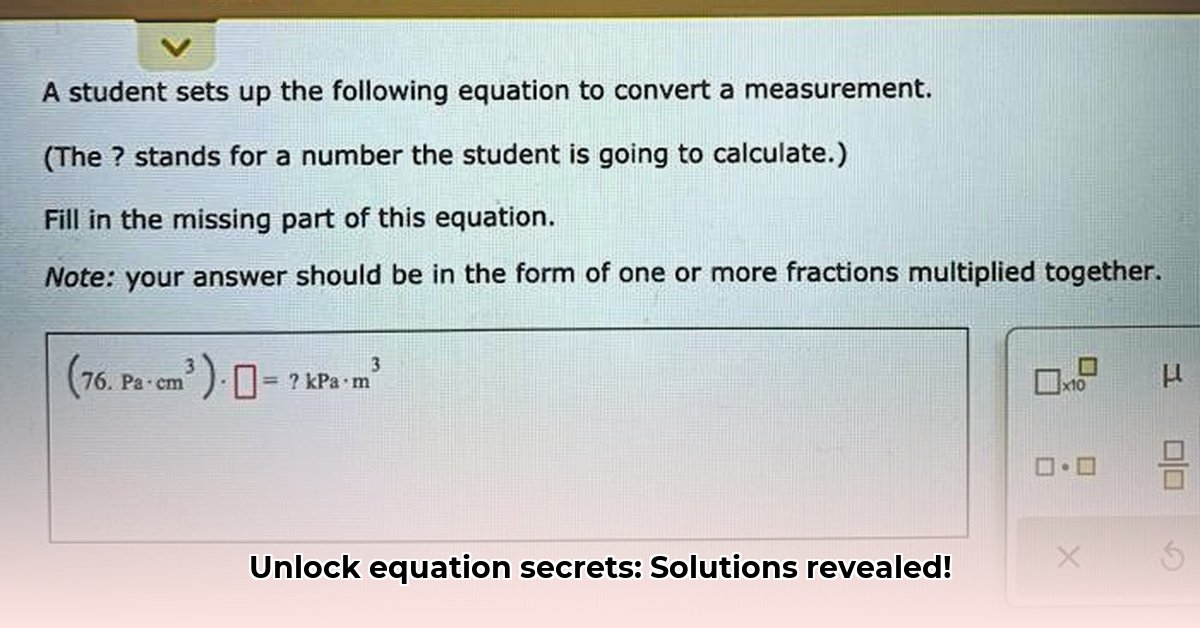
A Student Sets Up the Following Equation: Unlocking the Secrets of Equation Building
Equations can seem daunting, but setting them up is the key to solving math problems. Think of it like building a house: a strong foundation (the equation) leads to a successful outcome. This guide breaks down the process, showing how to transform word problems into solvable equations and avoid common mistakes.
From Words to Numbers: Tackling Word Problems
Many students struggle with translating word problems into equations. It's like translating between languages – from English to the language of math. The key is to identify the unknown quantities (variables like x, y, z) and use them to create a mathematical sentence (equation).
Example: "Sarah has seven more stickers than Tom. Together, they have 25 stickers. How many stickers does Tom have?"
Step-by-Step Solution:
Identify the Unknown: Tom's sticker count is the mystery; let's call it "x."
Represent the Clues: Sarah has x + 7 stickers (seven more than Tom).
Construct the Equation: Together they have 25 stickers: x + (x + 7) = 25.
We've successfully translated the word problem into a solvable equation.
Avoiding Common Equation Traps
Even experienced solvers make mistakes. Here are common pitfalls:
Variable Confusion: Always define what each variable represents (e.g., is x apples or the apple price?).
Misinterpreting the Problem: Carefully reread the problem to ensure your equation reflects the given information accurately.
Inconsistent Units: Maintain consistent units (e.g., centimeters, not a mix of centimeters and meters).
Ignoring Negative Solutions: Don't assume solutions are always positive; some problems legitimately have negative answers.
Strategies for Equation Success
Mastering equation building takes practice. Here are some helpful tips:
Divide and Conquer: Break complex problems into smaller, manageable parts.
Visual Aids: Use diagrams or charts to visualize the relationships in the problem.
Verify Your Solution: Substitute your answer back into the original equation to check its correctness.
Practice Regularly: Consistent practice builds confidence and skill.
Different Types of Equations
The type of equation used depends on the problem:
Linear Equations: (e.g., 2x + 5 = 9) involve variables raised to the power of one.
Quadratic Equations: (e.g., x² + 3x - 10 = 0) involve variables raised to the power of two, representing more complex relationships.
Simultaneous Equations: Systems of two or more equations with multiple unknowns, often used to solve real-world scenarios.
Mastering equation setup is crucial for understanding math and science. A systematic approach builds confidence and problem-solving abilities.
A Quick Equation Setup Reference
| Problem Type | Example | Equation Setup |
|---|---|---|
| Simple Addition/Subtraction | John has 5 apples, Mary has 3. Total apples? | 5 + 3 = x |
| Difference | Sarah has 8 more books than Mike. | x + 8 = y (x = Mike's books, y = Sarah's books) |
| Ratio/Proportion | 2 blue marbles for every 3 red marbles | 2/3 = x/y |
| Percentage Problems | Find 15% of 100 | 0.15 * 100 = x |
Careful reading, clear variable definitions, and a step-by-step approach are essential. With practice, you'll become proficient in solving equations.
How to Mitigate AI Bias in Personalized Educational Platforms
Key Takeaways:
- AI in education has immense potential but can reflect and amplify existing societal biases.
- A multi-faceted approach is needed to address this, involving developers, educators, policymakers, and students.
- Algorithm and data transparency are vital.
- Responsible educator implementation is crucial to counteract biased outputs.
- Effective policies, ethical guidelines, and ongoing improvement efforts are necessary.
AI is transforming education, but personalized learning platforms must be equitable. AI systems trained on biased data can perpetuate inequalities. This isn't about the AI being "bad"—it's about the data it's trained on.
Understanding the Bias
AI reflects society's biases. Data used to train AI often lacks diversity, creating algorithms that favor some groups over others. For example, automated essay scoring might unfairly penalize students with non-standard writing styles.
Mitigating the Problem: A Multi-Faceted Approach
Mitigating AI bias requires a comprehensive strategy:
Diverse Data: Developers must use diverse and representative datasets to reduce bias.
Transparent Algorithms: Algorithms should be transparent, allowing scrutiny and bias identification.
Educator Training: Teachers need training to recognize and mitigate bias in AI outputs.
Policy and Regulation: Governments should set standards for fairness and transparency.
Ongoing Monitoring: Continuous monitoring and evaluation are essential to identify and correct bias.
The Role of Each Stakeholder
| Stakeholder | Actions to Mitigate Bias |
|---|---|
| EdTech Developers | Use diverse datasets, build transparent algorithms, develop bias detection tools. |
| Educators | Receive bias awareness training, critically evaluate AI outputs, advocate for better tools. |
| Policymakers | Establish clear regulations, enforce transparency, fund bias research. |
| Students/Families | Develop critical thinking skills, question outputs, advocate for equitable systems. |
The goal is to create responsible AI systems that enhance education for all learners. Collaboration is key to ensuring fairness and equity in AI-powered education.